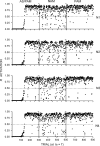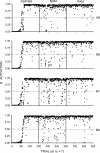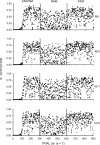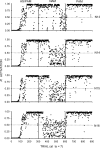Autoshaping and automaintenance: a neural-network approach
- PMID: 17725055
- PMCID: PMC1918088
- DOI: 10.1901/jeab.2007.75-04
Autoshaping and automaintenance: a neural-network approach
Abstract
This article presents an interpretation of autoshaping, and positive and negative automaintenance, based on a neural-network model. The model makes no distinction between operant and respondent learning mechanisms, and takes into account knowledge of hippocampal and dopaminergic systems. Four simulations were run, each one using an A-B-A design and four instances of feedfoward architectures. In A, networks received a positive contingency between inputs that simulated a conditioned stimulus (CS) and an input that simulated an unconditioned stimulus (US). Responding was simulated as an output activation that was neither elicited by nor required for the US. B was an omission-training procedure. Response directedness was defined as sensory feedback from responding, simulated as a dependence of other inputs on responding. In Simulation 1, the phenomena were simulated with a fully connected architecture and maximally intense response feedback. The other simulations used a partially connected architecture without competition between CS and response feedback. In Simulation 2, a maximally intense feedback resulted in substantial autoshaping and automaintenance. In Simulation 3, eliminating response feedback interfered substantially with autoshaping and automaintenance. In Simulation 4, intermediate autoshaping and automaintenance resulted from an intermediate response feedback. Implications for the operant-respondent distinction and the behavior-neuroscience relation are discussed.
Figures






Similar articles
-
Neural-network simulations of two context-dependence phenomena.Behav Processes. 2007 Jun;75(2):242-9. doi: 10.1016/j.beproc.2007.02.003. Epub 2007 Feb 8. Behav Processes. 2007. PMID: 17346905
-
Autoshaped choice in artificial neural networks: implications for behavioral economics and neuroeconomics.Behav Processes. 2015 May;114:63-71. doi: 10.1016/j.beproc.2015.01.010. Epub 2015 Feb 4. Behav Processes. 2015. PMID: 25662745
-
Topographical variations in behavior during autoshaping, automaintenance, and omission training.J Exp Anal Behav. 1987 May;47(3):319-33. doi: 10.1901/jeab.1987.47-319. J Exp Anal Behav. 1987. PMID: 16812484 Free PMC article.
-
"Automaintenance": the role of reinforcement.J Exp Anal Behav. 1974 Jan;21(1):117-24. doi: 10.1901/jeab.1974.21-117. J Exp Anal Behav. 1974. PMID: 16811725 Free PMC article.
-
Unified-theory-of-reinforcement neural networks do not simulate the blocking effect.Behav Processes. 2015 Nov;120:54-63. doi: 10.1016/j.beproc.2015.08.008. Epub 2015 Aug 28. Behav Processes. 2015. PMID: 26319369 Review.
Cited by
-
DDM-UI: A user interface in R for the discrepancy diffuse model in behavioral research.Behav Res Methods. 2025 Mar 28;57(5):128. doi: 10.3758/s13428-025-02648-9. Behav Res Methods. 2025. PMID: 40155588
-
Translations in Stimulus-Stimulus Pairing: Autoshaping of Learner Vocalizations.Perspect Behav Sci. 2019 Nov 25;43(1):57-103. doi: 10.1007/s40614-019-00228-9. eCollection 2020 Mar. Perspect Behav Sci. 2019. PMID: 32440645 Free PMC article.
-
Exploring the Potential of Variational Autoencoders for Modeling Nonlinear Relationships in Psychological Data.Behav Sci (Basel). 2024 Jun 25;14(7):527. doi: 10.3390/bs14070527. Behav Sci (Basel). 2024. PMID: 39062350 Free PMC article.
-
Machine Learning for Supplementing Behavioral Assessment.Perspect Behav Sci. 2021 Jan 9;44(4):605-619. doi: 10.1007/s40614-020-00273-9. eCollection 2021 Dec. Perspect Behav Sci. 2021. PMID: 35098027 Free PMC article.
-
Tutorial: Applying Machine Learning in Behavioral Research.Perspect Behav Sci. 2020 Nov 10;43(4):697-723. doi: 10.1007/s40614-020-00270-y. eCollection 2020 Dec. Perspect Behav Sci. 2020. PMID: 33381685 Free PMC article.
References
-
- Bennett M.R, Hacker P.M.S. Philosophical foundations of neuroscience. Malden, MA: Blackwell; 2003.
-
- Berger T.W, Alger B, Thompson R.F. Neuronal substrate of classical conditioning in the hippocampus. Science. 1976 Apr 30;192:483–485. - PubMed
-
- Bindra D. A unified account of classical and operant training. In: Black A.H, Prokasy W.F, editors. Classical conditioning II: Current research and theory. New York: Appleton-Century-Crofts; 1972. pp. 453–481.
Publication types
MeSH terms
LinkOut - more resources
Full Text Sources

